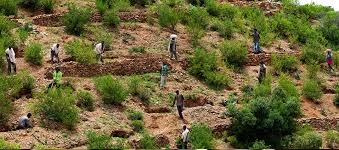
Ownership of the land also plays a meaningful role in the protection of the land and the subsequent impact on environment. For many centuries, land in Ethiopia was administered under various forms of tenure system. For instance, in the northern parts of the country including Gojam, Gonder, Wollo, Shewa, and Tigray the Rist system had been the main feature of the tenure system until the promulgation of the 1974 land proclamation which declared that land belonged to the government.
Under the Rist system land belonged to the community. A land-owning member of the community is entitled to a right to transfer his land title to family line. The product derived from the land belonged to the farmers who paid tribute to the then feudal regimes. Farmers had somehow tenure security and protected from arbitrary eviction.
In the southern part of the country, however, the reality was different. The land belonged to land lords where the farmer is a mere tenant. They had no sense of ownership and lack security. Therefore, the land was not handled with due sense of responsibility.
The centuries old feudal land system, characterized by oppression and exploitation had ignited resentment among various groups of the public. One of the slogans of the student movement in 1960s was “land to the tiller” intended to defend the rights of the farmers.
In 1974 when the feudal regime was overthrown by popular resentment, the new Dergue regime introduced new land proclamation, which nationalized the land. According to the then land activists, the Dergue land proclamation did not address the land question instead, the proclamation gave a monopoly ownership to the Dergue which emanated from socialist ideology.
It did not give ownership rights to farmers; it only rendered them to use rights and ultimately it made land devoid of transaction value. That proclamation is still legal to date. The land system has not brought meaningful socio-economic transformation to the nation. The nation is still one of food recipient country in the world.
Currently due to population growth and the growing scarcity, according to experts in the rural part of the country 50 percent of the farmers have less than one hectare land in such practice attaining surplus production is unrealistic.
When their children reach above 18 years old farmers will be forced to provide portion of the land to them which intern further fragment the plot.
Erosion and land degradation by human activities have been a common phenomenon in the rural part which reduced land productivity. The current climate change and global warming further threaten the sector and posed crop failure.
To modernize the agricultural production and productivity injecting finance to the sector through pouring investment, is irreplaceable way out and to that end looking solution to the land holding system and restoring the transaction value of land is essential.
The Government of the Democratic Republic of Ethiopia has vigorously promoted policies and institutional arrangements that provide an enabling environment for implementing the national land use policy so that social and economic issues and environmental concerns for the sustainable use of land resources are addressed effectively. This enabling environment includes appropriate legal, knowledge and institutional frameworks.
As to experts it is obvious that, the legislative framework on land use and natural resources tenure has significant gaps, ambiguities or inconsistencies and contradictions in laws and regulations regarding communal lands and property rights, public lands, the right of individuals and communities on natural resources like fishing, water, forest, minerals, communal pastoral lands, fishing grounds and real estate.
It is imperative that appropriate implementable and enforceable laws are formulated to address this gap in order to implement the national land use policy efficiently.
The existing laws, regulations and guidelines shall be reviewed, conflicting provisions harmonized and existing gaps filled with new provisions. Furthermore, these laws and regulations should be rigorously enforced and the authorities enforcing them shall be clearly defined.
It is essential that formulation and revision of laws supporting the national land use policy and its implementation have to be informed by scientific knowledge and evidence on the ground in a situation of dynamic changes taking place in land use and land cover. According to experts, institutions responsible to implement the national land use policy should establish a repository and data sharing platform on land administration, management, land evaluation, land use and land cover data to ensure, facilitate and coordinate the collection, processing, storage, retrieval and dissemination of this information among federal and regional sector ministries, agencies and bureaus.
It is also important that the public can access processed information on land administration and management and land use and land cover.
The general features of the data and information system on land resources to be collected include spatial distribution, quality of resource, status in terms of level of degradation, socioeconomic values, public good and eco-system services they provide, management techniques and technologies (including indigenous and traditional knowledge and technologies).
In addition, it shall encourage and promote research on land related issues by identifying topics of research and arranging for their funding. Discussion forums for disseminating results of land related research, monitoring, and evaluation of land policy implementation and impacts as well as new thinking and ideas on land governance should be promoted and supported.
The pertinent institute should arrange for monitoring regularly implementation of the land use policy and its socio-economic and environmental impacts. Impacts will be measured against set performance indicators model including, Sustainable use of land resources, maintenance of adequate strategic resources such as forests, wetlands, heritage and protected areas, coordination of planning, policy implementation and legal reforms in all sectors related to land use.
In addition, integration of gender concerns in the general land use planning and implementation ensuring equitable use of natural resources.
The Ethiopian public needs to be aware of its rights of land use and the obligations that come with it and the processes and procedures of land use right registration, land management, valuation etc. It should also be informed and educated on appropriate sustainable land use practices so that it will be part of the solution rather than the problem.
Implementation of a proactive public awareness and information strategy throughout the formulation of the land use policy and its implementing laws as well as individual and collective participation in its implementation is crucial for success.
A sound and equitable system of land governance is essential if the national land use policy is to be implemented successfully and the targets set for sustainable natural resources management, social stability and economic development are to be attained.
An effective and proactive institution responsible for land governance, situated at an appropriate position in the federal government structure will be required to put in place the appropriate legal and knowledge frameworks and prepare and coordinate implementation of the integrated national land use plan described in this policy document.
Currently, the responsibility of land administration, land management and spatial information is scattered across relevant ministries and agencies which renders harmonization of policies, laws and coordinated implementation of these and the integrated national land use plan very difficult, if not impossible.
Studies conducted in the land use policy development process indicate that the unplanned and unguided haphazard land use in the country has inflicted considerable damage to agricultural land, wetlands, and important fauna, flora, and the natural resource base of the country as a whole. There is consensus that this dangerous situation has to be stopped and mitigated.
The Federal Government has to establish a single effective institution that is well resourced with staff, which have the requisite technical knowledge and with adequate budget to be responsible for land affairs in the country. It also needs to have authority to enforce national land use policy and laws and independence from political interference in carrying out its duties and responsibilities.
Many countries in Africa have national institution combining land administration, land valuation and management, land surveying and registration for both rural and urban lands and geospatial information management. Such national land institutions are given different names in different countries but they perform similar functions and responsibilities.
The Federal Government has to undertake a thorough review and analysis of the international experience and conduct an in-depth stakeholder consultation in establishing and operating this national institution before making such a decision with far reaching consequences.
BY ABEBE WOLDEGIORGIS
THE ETHIOPIAN HERALD SUNDAY EDITION 13 APRIL 2025





